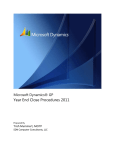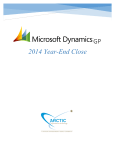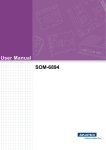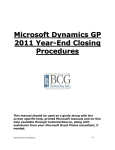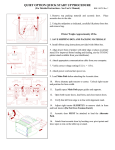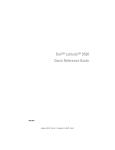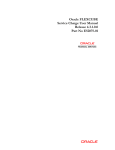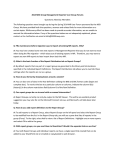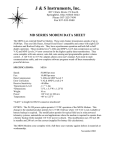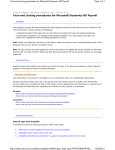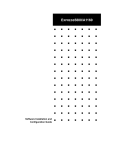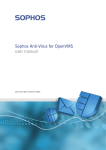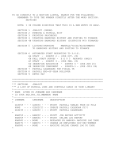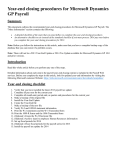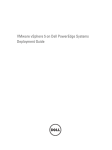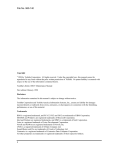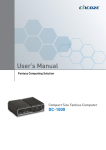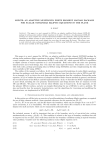Download Follow the link to all closing instructions
Transcript
5175 Selma Road Springfield, Ohio 45502 P 937-265-5588 F 937-265-5388 Year-end close procedures – for all modules in order Complete the posting procedures and the closing procedures for other modules. Only follow this step if General Ledger is integrated with other modules. If General Ledger is not integrated with other modules, skip this step. a. Post final transactions in all the modules except in General Ledger. b. Complete the month-end procedure and the quarter-end procedure for all the modules except for General Ledger. c. Complete the year-end closing procedures for each module in the following order: Inventory Post all transactions for the year. Make sure that all Invoicing transactions, Sales Order Processing transactions, and Inventory transactions for the current year have been entered and then posted before you close the year. This is true so that historical information is accurate for the year you are closing, and year-to-date amounts are accurately stated for the new year. If you want to enter future-period transactions before closing the year, create a new batch that has new transactions. However, do not post the batch until after the year has been closed. 1. Reconcile inventory quantities. Reconcile quantities for all items by using the Reconcile Inventory Quantities window to make sure that your Inventory Control data has not become damaged during the year. To open the Reconcile Inventory Quantities window, follow one of these steps: In Microsoft Dynamics GP 2010 and Microsoft Dynamics GP 10.0, point to Tools on the Microsoft Dynamics GP menu, point to Utilities, point to Inventory, and then click Reconcile. In Microsoft Dynamics GP 9.0 and in earlier versions, point to Inventory on the Utilities menu, and then click Reconcile. If any differences are found during the reconcile process, the quantities will be adjusted. If adjustments are made, they will be reflected on the Reconcile Report. Additionally, any serial numbers and lot numbers that were added for the adjusted items are included. If you want to change these serial numbers and lot numbers, you can use the Item Transaction Entry window. Enter decrease adjustment transactions to remove the existing serial numbers and the existing lot numbers. Then, enter increase adjustment transactions to enter the correct serial numbers and the correct lot numbers. To open the Item Transaction Entry window, point to Inventory on the Transactions menu, and then click Transaction Entry. 2. Complete a physical inventory count, and then post any adjustments. 1|Page o 5175 Selma Road Springfield, Ohio 45502 P 937-265-5588 937-265-5388 Use theFStock Calendar Maintenance window to set up and then maintain information about when stock counts can be performed and about which days will be counted when the system calculates suggested dates for the next stock count for a specific item-site combination. To open the Stock Calendar Maintenance window, follow one of these steps: In Microsoft Dynamics GP 2010 and Microsoft Dynamics GP 10.0, point to Tools on the Microsoft Dynamics GP menu, point to Setup, point to Inventory, and then click Stock Calendar. In Microsoft Dynamics GP 9.0 and in earlier versions, point to Setup on the Tools menu, point to Inventory, and then click Stock Calendar. The Stock Count Cycle Assignment window can be used if you want to assign one stock count o frequency to many items. To open the Stock Count Cycle Assignment window, point to Inventory on the Cards menu, and then click Count Cycle Assignment. Create a Stock Count Schedule. A Stock Count Schedule is a list of the specific items at a specific o site that will be counted during a specific count. When you start a stock count schedule, the quantity on hand for each line in the stock count schedule is captured. Later, the actual count number quantities will be compared to the captured values to create default variance transactions. Stock Count Forms can be printed during this process. To open the Stock Count Schedule window, point to Inventory on the Transactions menu, and then click Stock Count Schedule. Use the Stock Count Entry window to enter information about the results of your stock counts. o When you process a stock count, variance transactions are created. If the Autopost Stock Count Variances check box is selected, the transactions will also be posted. To open the Stock Count Entry window, point to Inventory on the Transactions menu, and then click Stock Count Entry. Instead of following step 3, you can manually create your adjusting entries. To do this, print a Physical Inventory Checklist by using the Inventory Activity Reports window, and then perform a physical count of your Inventory Items to verify that quantity on hand amounts are accurate for all Items. To open the Inventory Activity Reports window, point to Inventory on the Reports menu, and then click Activity. 3. Print additional reports. Print any additional reports that you will need for planning or for your permanent records. The suggested reports are as follows: o Stock Status Report o Purchase Receipts Report o Turnover Report o Transaction History Report o Serial Number List o Lot Number List To access the Reports palette, point to Inventory on the Reports menu. Use selections from the Inventory Reports palette to print these reports. If you plan to remove sold purchase receipts during the year-end 2|Page 5175 Selma Road Springfield, Ohio 45502 P 937-265-5588 937-265-5388 closing process, Fwe recommend that you print the Purchase Receipts Report to review the receipts that will be removed. 4. Make a backup. Make a backup of all company data. This is true so that you will be able to recover quickly should a power fluctuation or other problem occur during the year-end closing procedure. 5. Close the year. Closing a year performs the following tasks: Transfers all summarized current-year quantity (cost and sales amounts) to transaction history for the Items for which you have been keeping summarized sales history. Updates the amount in the item's Beginning Quantity field to the Quantity on Hand field at each o site. Certain reports, such as the Turnover Report, use the amount in the Beginning Quantity field for report calculations. o Zeros the Quantity Sold field in Item Quantities Maintenance window for each site. o Removes purchase receipts and cost change history for items that have been completely sold. o Removes any discontinued items from the Item records that have been completely sold. Removes any lot attributes from the records of lot numbered items if they have been completely o sold. Updates the standard cost of each item to the current cost if you use either the FIFO periodic o method or the LIFO periodic valuation method. Uses the Inventory Year-End Closing window to close the year. o The following options are available. Remove discontinued items If you click to select the Discontinued Items check box, all discontinued Items that have a zero balance will be removed during the year-end closing process. Items can be designated as discontinued by using the Item Maintenance window. Discontinued Items that have a quantity on hand of zero (except for kit components) and have no unposted transactions will be completely removed from the Inventory module. If you use the Service Call Management module, determine whether any discontinued items exist on any unposted service documents. If discontinued items exist on any unposted service documents, the documents must be posted before you continue. The Sales Order Processing report, the Invoicing report, or the Purchase Order Processing report and inquiries will still be able to display information about these discontinued items. However, you will be unable to perform a lookup on the Item Number because it has been removed from the Item Master table. If you want to print a report or inquire on the discontinued Item, you must include the item within the Item Number range. Note: If you select this option, you will remove the discontinued items. Additionally, you will 3|Page 5175 Selma Road Springfield, Ohio 45502 P 937-265-5588 937-265-5388 removeF all inventory history for the items. You will be unable to drill back on the inventory history for these items. Remove sold receipts If you click to select the Sold Receipts check box, all sold receipts whose quantity received amounts and quantity sold amounts are equal will be removed. This is an optional step, and it may not be a procedure that is performed every year-end. These values may help when items are returned through Invoicing. Therefore, you may not want to remove the purchase receipts from the file. In Microsoft Dynamics GP 2010, Microsoft Dynamics GP 10.0 or in Microsoft Dynamics GP 9.0: Remove: Sold Receipts and Cost Change History Prior To. You click to select the Sold Receipts and Cost Change History Prior To check box to remove all sold purchase receipts and historical cost changes for items that use Average Perpetual, Last In, First Out (LIFO) Perpetual, or the First In, First Out (FIFO) Periodic valuation method, and then you enter a date. The sold receipts, quantity sold details, and historical cost changes with dates that come before the date that you entered will be removed. In Microsoft Business Solutions - Great Plains 8.0: Remove: Sold Receipts. If you click to select the Sold Receipts check box, all sold receipts whose quantity received amount and quantity sold amount are equal will be removed. This is an optional step, and it may not be a procedure that is performed every year-end. These values may help when items are returned through Invoicing. Therefore, you may not want to remove the purchase receipts from the file. Remove sold lot attributes If you click to select the Sold Lot Attributes check box, values for completely sold lot numbers will be removed. For example, you can remove the value red for the lot attribute Color if you have sold all lot numbered items that have been assigned the value red. Update an item's standard cost If you click to select the Item's Standard Cost check box, the Standard Cost for any items that have been assigned the FIFO periodic valuation method or the LIFO periodic valuation method will be adjusted automatically to reflect each item's current cost or the amount you most recently paid for the item. If you are registered for the Manufacturing module, you will be unable to select the Item's Standard Cost check box. When you have selected all the options that you want, click Process to start the year-end closing process. When the year is being closed, you will be unable to post, reconcile quantities, change valuation methods, or change decimal places for items. 6. Close the fiscal periods for the Inventory series (optional). You can use the Fiscal Periods Setup window to close fiscal periods that are still open for the year. To open the Fiscal Periods Setup window, follow one of these steps: In Microsoft Dynamics GP 2010 and Microsoft Dynamics GP 10.0, point to Tools on the o Microsoft Dynamics GP menu, point to Setup, point to Company, and then click Fiscal Periods. 4|Page o 5175 Selma Road Springfield, Ohio 45502 P 937-265-5588 F 937-265-5388 In Microsoft Dynamics GP 9.0 and in earlier versions, point to Setup on the Tools menu, point to Company, and then click Fiscal Periods This keeps transactions from accidentally being posted to the wrong period or year. Make sure that you have posted all transactions for the period and year for all modules before closing fiscal periods. If you later have to post transactions to a fiscal period you have already closed, you must return to the Fiscal Periods Setup window to reopen the period before you can post the transaction. 7. Make a final backup. Make a final backup of the company data files and keep it in safe, permanent storage. This gives you a permanent record of the company's financial position at the time that you closed the year. 5|Page 5175 Selma Road Springfield, Ohio 45502 P 937-265-5588 F 937-265-5388 Receivables Step 1: Post all the sales and receivables transactions for the year Post all the sales and receivables transactions for the year before you close the year. If you want to enter any sales and receivables transactions for a future period before you close the year, create a batch that contains the transactions. Next, save the batch. Then, post the batch after you close the year. You must close the year because some areas of Microsoft Dynamics GP are not date sensitive. If you do not close the year after you enter all the 2011 transactions and before you enter all the 2012 transactions, these areas will contain incorrect information. However, if you have to change the information, you can change the information in the Amounts Since Last Close view in the Customer Summary window and in the Customer Finance Charge Summary window. The following areas are the areas of Microsoft Dynamics GP that are not date sensitive. The Amounts Since Last Close view in the Customer Summary window To open the Amounts Since Last Close view in the Customer Summary window, follow these steps: 1. On the Cards menu, point to Sales, and then click Summary. 2. In the Customer Summary window, type a customer ID in the Customer ID box. 3. In the Summary View list, click Amounts Since Last Close. The Customer Finance Charge Summary window To open the Customer Finance Charge Summary window, follow these steps: 1. On the Cards menu, point to Sales, and then click Summary. 2. In the Customer Summary window, type a customer ID in the Customer ID field. 3. Click Finance Charges. The SmartList objects To view the SmartList columns that are affected, follow these steps: 1. Use the appropriate method: In Microsoft Dynamics GP 10.0 or Microsoft Dynamics GP 2010, click Columns on the Microsoft Dynamics GP menu, click SmartList, expand Sales, expand Customers, and then click Add. In Microsoft Dynamics GP 9.0, click SmartList on the View menu, expand Customers, click Columns, and then click Add. 2. Select the following items in the Available Columns list. 6|Page 5175 Selma Road Springfield, Ohio 45502 P 937-265-5588 F 937-265-5388 Note The items that are flagged with an asterisk are affected by the calendar year-end close. All the other items are affected by the fiscal year-end close. 7|Page Average Days to Pay - Year Finance Charges CYTD* Finance Charges LYR Calendar* High Balance LYR High Balance YTD Number of ADTP Documents - LYR Number of ADTP Documents - Year Number of NSF Checks YTD Total # FC LYR* Total # FC YTD* Total # Invoices LYR Total # Invoices YTD Total Amount of NSF Check YTD Total Bad Debt LYR Total Bad Debt YTD Total Cash Received LYR Total Cash Received YTD Total Discounts Available YTD Total Discounts Taken LYR Total Discounts Taken YTD Total Finance Charges LYR* Total Finance Charges YTD* Total Returns LYR Total Returns YTD Total Sales LYR Total Sales YTD Total Waived FC LYR* Total Waived FC YTD* Total Writeoffs LYR Total Writeoffs YTD Unpaid Finance Charges YTD* Write Offs LYR Write Offs YTD 5175 Selma Road Springfield, Ohio 45502 P 937-265-5588 F 937-265-5388 3. Click OK. 4. Click OK. Step 2: Make a pre-year-end closing backup Create a backup before you close the year. Put the backup in safe, permanent storage. This backup makes sure that you have a permanent record of the company's financial position at the end of the year. You can restore information from this backup if you have to. For example, this backup would let you quickly recover if a power fluctuation or another problem occurred during the year-end close procedure. To create a backup in Microsoft Dynamics GP, follow these steps: 1. Use the appropriate method: o In Microsoft Dynamics GP 10.0 or Microsoft Dynamics GP 2010, point to Maintenance on the Microsoft Dynamics GP menu, and then click Backup. o In Microsoft Dynamics GP 9.0, click Backup on the File menu. 2. In the Back Up Company window, select the company name in the Company Name list. 3. Change the path of the backup file if it is required, and then click OK. Note We recommend that you name this backup PreYearEndClosingBackup2011. Step 3: Close the year 1. Use the appropriate method: o In Microsoft Dynamics GP 10.0 or Microsoft Dynamics GP 2010, point to Tools on the Microsoft Dynamics GP menu, point to Routines, point to Sales, and then click Year-End Close. o In Microsoft Dynamics GP 9.0, point to Routines on the Tools menu, point to Sales, and then click YearEnd Close. 2. If you are closing both the fiscal year and the calendar year at the same time, click All. If you are closing only the calendar year, click Calendar. If you are closing only the fiscal year, click Fiscal. 3. Click to select the Print Report check box, and then click Close Year. Note We recommend that you keep a paper copy of the year-end report together with the permanent year-end audit records. Calendar year details The calendar year-end process in Microsoft Dynamics GP clears the following fields in the Customer Summary window: Finance Charges CYTD Total # FC YTD 8|Page 5175 Selma Road Springfield, Ohio 45502 P 937-265-5588 F 937-265-5388 Total Finance Charges YTD Total Waived FC YTD Unpaid Finance Charges YTD The calendar year-end process updates the amounts in the following fields: *Finance Charges LYR Calendar *Total # FC LYR Fiscal year details The fiscal year-end process in Microsoft Dynamics GP clears the following fields in the Customer Summary window: Average Days to Pay - Year High Balance YTD Number of ADTP Documents - Year Number of NSF Checks YTD Total # Invoices YTD Total Amount of NSF Check YTD Total Bad Debt YTD Total Cash Received YTD Total Discounts Available YTD Total Discounts Taken YTD Total Returns YTD Total Sales YTD Total Writeoffs YTD Write Offs YTD The fiscal year-end process updates the amounts in the following fields: High Balance LYR Number of ADTP Documents - LYR Total # Invoices LYR Total Bad Debt LYR Total Cash Received LYR Total Discounts Taken LYR Total Returns LYR Total Sales LYR Total Writeoffs LYR Write Offs LYR Step 4: Close the fiscal periods (This step is optional) 9|Page 5175 Selma Road Springfield, Ohio 45502 P 937-265-5588 F 937-265-5388 To prevent users from accidentally posting transactions to the wrong period or to the wrong year, use the Fiscal Periods Setup window to close all fiscal periods that are still open for the year. Before you close fiscal periods, verify that you have posted all the transactions for the period and for the year for all modules. If you must later post transactions to a fiscal period that you already closed, you can return to the Fiscal Periods Setup window to reopen the period so that you can post the transactions. To close a fiscal period, follow these steps: 1. Use the appropriate method: o In Microsoft Dynamics GP 10.0 or Microsoft Dynamics GP 2010, point to Tools on the Microsoft Dynamics GP menu, point to Setup, point to Company, and then click Fiscal Periods. o In Microsoft Dynamics GP 9.0, point to Setup on the Tools menu, point to Company, and then click Fiscal Periods. 2. Click to select the Sales check box for the period that you want to close. Step 5: Close the tax year Note Follow these steps only after you complete the year-end closing procedures for all the sales and purchasing modules. To close the tax year, follow these steps: 1. Use the appropriate method: o In Microsoft Dynamics GP 10.0 or Microsoft Dynamics GP 2010, point to Tools on the Microsoft Dynamics GP menu, point to Routines, point to Company, and then click Tax Year-End Close. o In Microsoft Dynamics GP 9.0, point to Routines on the Tools menu, point to Company, and then click Tax Year-End Close. 2. Click to select the Close Year check box, and then click to select the Print Report check box. 3. Click Process. Note We recommend that you keep a paper copy of the year-end report together with the permanent year-end audit records. Step 6: Make a post-year-end closing backup Create a backup after you close the year. Put the backup in safe, permanent storage. This backup makes sure that you have a permanent record of the company's financial position at the end of the year. You can restore information from this backup if you have to. For example, this backup would let you quickly recover if a power fluctuation or another problem occurred during the year-end close procedure. To create a backup in Microsoft Dynamics GP, follow these steps: 1. Use the appropriate method: 10 | P a g e 5175 Selma Road Springfield, Ohio 45502 P 937-265-5588 F 937-265-5388 o In Microsoft Dynamics GP 10.0 or Microsoft Dynamics GP 2010, point to Maintenance on the Microsoft Dynamics GP menu, and then click Backup. o In Microsoft Dynamics GP 9.0, click Backup on the File menu. 2. In the Back Up Company window, click the company name in the Company Name list. 3. Change the path of the backup file if it is required, and then click OK. Note We recommend that you name this backup PostYearEndClosingBackup2011. Year-to-date finance charges on customer statements for December and for January Year-to-date finance charges are not automatically printed on customer statements for December and for January. December statements To add the year-to-date finance charges to the December statements, follow these steps: 1. Use the appropriate method: o In Microsoft Dynamics GP 10.0 or Microsoft Dynamics GP 2010, point to Tools on the Microsoft Dynamics GP menu, point to Customize, and then click Report Writer. o In Microsoft Dynamics GP 9.0, point to Customize on the Tools menu, and then click Report Writer. 2. In the Product list, click Microsoft Dynamics GP, and then click OK. 3. Click Reports. 4. Use the appropriate method: o If you have not previously modified the statement form, click the statement form that you print in the Original Reports list, click Insert, and then click the statement form in the Modified Reports list. o If you previously modified the statement form, click the statement form in the Modified Reports list. 5. Click Open. 6. In the Report Definition window, click Tables. 7. In the Report Table Relationships window, click RM Customer MSTR, and then click New. 8. In the Related Tables window, click Customer Master Summary, and then click OK. 9. Click Close. 10. Click Layout. 11. In the resource list in the Toolbox box, click Customer Master Summary. 12. In the field list, drag Finance Charges CYTD to the layout of the report. You can position this field in any section of the report. 13. On the File menu, click Microsoft Dynamics GP. When you are prompted to save the changes, click Save. 14. If you have not previously modified this report, you must grant security to the report. To do this, use the appropriate method. 11 | P a g e 5175 Selma Road Springfield, Ohio 45502 P 937-265-5588 F 937-265-5388 Microsoft Dynamics GP 10.0 or Microsoft Dynamics GP 2010 a. On the Microsoft Dynamics GP menu, point to Tools, point to Setup, point to Systems, and then click Alternate/Modified Forms and Reports. b. In the ID box, enter the user ID. c. In the Product list, click Microsoft Dynamics GP. d. In the Type list, click Reports. e. Expand Sales, and then expand the node of the modified form. f. Click Microsoft Dynamics GP (Modified). Microsoft Dynamics GP 9.0 Use one of the following methods. o Use the Advanced Security tool. To do this, follow these steps: a. On the Tools menu, point to Setup, point to System, and then click Advanced Security. If you are prompted, type the system password. b. Click View, and then click by Alternate, Modified and Custom. c. Expand Microsoft Dynamics GP, expand Reports, expand Sales, and then expand the statement form. d. Click Microsoft Dynamics GP (Modified). e. Click Apply, and then click OK. Note By default, the current user and the current company are selected when you start the Advanced Security tool. Any changes that you make are for the current user and the current company. However, you can select additional users in the User area of the Advanced Security window. You can select additional companies in the Company area of the Advanced Security window. o Use standard Microsoft Dynamics GP security. To do this, follow these steps: . On the Tools menu, point to Setup, point to System, and then click Security. If you are prompted, type the system password. a. In the User ID list, click the user ID of the user who you want to access the report. b. In the Type list, click Modified Reports. c. In the Series list, click Sales. d. In the Access List box, double-click the statement form, and then click OK. An asterisk appears next to the report name. January statements 12 | P a g e 5175 Selma Road Springfield, Ohio 45502 P 937-265-5588 F 937-265-5388 To add the year-to-date finance charges to the January statements, follow these steps: 1. Follow steps 1 through 11 in the "December statements" section. 2. In the field list, drag Finance Charges LYR Calendar to the layout of the report. You can position this field in any section of the report. 3. Follow steps 13 and 14 in the "December statements" section. 13 | P a g e 5175 Selma Road Springfield, Ohio 45502 P 937-265-5588 F 937-265-5388 Payables Management Step 1: Post all transactions for the year Post all transactions for the year before you close the year. If you want to enter future period transactions before you close the year, create a new batch for the future period transactions. Save the future period transactions in the new batch, but do not post the new batch until after the year has been closed. The following areas of Microsoft Dynamics GP are not date-sensitive: The Amounts Since Last Close view of the Vendor Yearly Summary window SmartList objects Vendor Summary reports These areas of Microsoft Dynamics GP will be incorrect if you do not close the payables year after you enter all 2011 transactions and before you enter all 2012 transactions. However, the Amounts Since Last Close view of the Vendor Yearly Summary window is editable. Therefore, you can update the information in the Amounts Since Last Close view of the Vendor Yearly Summary window if it is required. To access the Amounts Since Last Close view of the Vendor Yearly Summary window, follow these steps: 1. On the Cards menu, point to Purchasing, and then click Summary. 2. In the Vendor Credit Summary window, type a vendor ID in the Vendor ID field, and then click Yearly. 3. In the Summary View list, click Amounts Since Last Close. To view the SmartList columns that are affected, follow these steps: 1. Open SmartList. To do this, use the appropriate step: o In Microsoft Dynamics GP 10.0 or Microsoft Dynamics GP 2010, click SmartList on the Microsoft Dynamics GP menu. o In Microsoft Dynamics GP 9.0, click SmartList on the View menu. 2. Use the appropriate step: o In Microsoft Dynamics GP 10.0 or Microsoft Dynamics GP 2010, expand the Purchasing node, and then click Vendors. o In Microsoft Dynamics GP 9.0, click Vendors. 3. Click Columns. 4. Click Add. 5. Click the following fields in the Available Columns list. Note The items flagged with an asterisk are affected by the calendar year-end close. All other items are affected by the fiscal year-end close. 14 | P a g e 5175 Selma Road Springfield, Ohio 45502 P 937-265-5588 F 937-265-5388 o *1099 Amount YTD o *1099 Amount LYR o Amount Billed YTD o Amount Billed LYR o Amount Paid YTD o Amount Paid LYR o Average Days To Pay - Year o Discount Available LYR o Discount Available YTD o Discount Lost LYR o Discount Lost YTD o Discount Taken LYR o Discount Taken YTD o Finance Charge LYR o Finance Chare YTD o Number of Finance Charges LYR o Number of Finance Charges YTD o Number of Invoice LYR o Number of Invoice YTD o Number of Paid Invoice YTD o Returns LYR o Returns YTD o Trade Discounts Taken LYR o Trade Discounts Taken YTD o Withholding LYR o Withholding YTD o Write Offs LYR o Write Offs YTD 6. Click OK. 7. Click OK. To view the Vendor Summary reports, follow these steps: 1. On the Reports menu, point to Purchasing, and then click Analysis. 2. In the Reports list, click Calendar Year. 3. In the Options list, click an option, and then click Print. Step 2: Print the Aged Trial Balance with Options report 15 | P a g e 5175 Selma Road Springfield, Ohio 45502 P 937-265-5588 F 937-265-5388 We recommend that you print a paper copy of the Aged Trial Balance with Options report to keep with your year-end permanent financial records. To do this, follow these steps: 1. On the Reports menu, point to Purchasing, and then click Trial Balance. 2. In the Reports list, click Aged Trial Balance with Options. Step 3: Print the Vendor Period Analysis report We recommend that you print a paper copy of the Vendor Period Analysis report to keep with your year-end permanent financial records. To do this, follow these steps 1. On the Reports menu, point to Purchasing, and then click Analysis. 2. In the Reports list, click Period. Step 4: Install the Payroll year-end update (optional) If there are compliance changes for Payables Management, such as 1099 form changes, install the Payroll year-end update. If there are no changes or compliance issues for the tax year for Payables Management, you may skip this step. Review the changes that are included in the Payroll year-end update. To do this, visit the appropriate Microsoft Web site: Customers https://mbs.microsoft.com/customersource/downloads/taxupdates Partners https://mbs.microsoft.com/partnersource/support/selfsupport/taxupdates/ Step 5: Make a backup that is named "Pre-1099 Edits" Create a backup, and then put the backup in safe, permanent storage. A backup gives you a permanent record of the company's financial position at the end of the year, and this backup can be restored later if it is required. A backup lets you recover data quickly if a power fluctuation or other problem occurs during the year-end closing procedure. To create a backup in Microsoft Dynamics GP, follow these steps: 1. Use the appropriate step: o In Microsoft Dynamics GP 10.0 or Microsoft Dynamics GP 2010, point to Maintenance on the Microsoft Dynamics GP menu, and then click Backup. o In Microsoft Dynamics GP 9.0, click Backup on the File menu. 2. In the Company Name list, click your company name. 3. Change the path of the backup file if it is required, and then click OK. Note We recommend that you name this backup "Pre-1099 Edits" to differentiate it from your other backups. Step 6: Verify the 1099 information and edit it if it is required 16 | P a g e 5175 Selma Road Springfield, Ohio 45502 P 937-265-5588 F 937-265-5388 To print the 1099 edit list, follow these steps: 1. Use the appropriate step: o In Microsoft Dynamics GP 10.0 or Microsoft Dynamics GP 2010, point to Tools on the Microsoft Dynamics GP menu, point to Routines, point to Purchasing, and then click Print 1099. o In Microsoft Dynamics GP 9.0, point to Routines on the Tools menu, point to Purchasing, and then click Print 1099. 2. On the File menu, click Print. To edit the 1099 information for a vendor, follow these steps. Microsoft Dynamics GP 10.0 or Microsoft Dynamics GP 2010 To open the "1099 Details" window, use one of the following methods. Method 1 1. On the Cards menu, point to Purchasing, and then click 1099 Details. 2. In the Vendor ID list, click a vendor ID. 3. In the Tax Type list, select one of the following: o Dividend o Interest o Miscellaneous 4. In the Display area, click Month or Year, and then type 2011 in the Year field. 5. In the Amount column, type the correct 1099 amount. 6. Click Save. Method 2 1. On the Cards menu, point to Purchasing, and then click Summary. 2. In the Vendor ID list, click a vendor ID, and then click Period. 3. In the Year field, type 2011. 4. In the Month/Period field, select the appropriate month or period. 5. Click the "1099 Details" button that appears next to the 1099 Amount field. 6. In the Amount column, type the correct 1099 amount. Microsoft Dynamics GP 9.0 1. On the Cards menu, point to Purchasing, and then click Summary. 2. In the Vendor ID field, type the ID of the vendor whose 1099 amounts you must edit, and then click Period. 3. In the Year field, type 2011. 4. In the Month/Period field, type the number of the period that you must edit. 5. In the 1099 Amount field, type the correct 1099 amount. 6. Click Save. 17 | P a g e 5175 Selma Road Springfield, Ohio 45502 P 937-265-5588 F 937-265-5388 Step 7: Print the 1099 statements Note You can do this at any time. To print the 1099 statements, follow these steps: 1. Use the appropriate step: o In Microsoft Dynamics GP 10.0 or Microsoft Dynamics GP 2010, point to Tools on the Microsoft Dynamics GP menu, point to Routines, point to Purchasing, and then click Print 1099. o In Microsoft Dynamics GP 9.0, point to Routines on the Tools menu, point to Purchasing, and then click Print 1099. 2. In the 1099 Year field, type 2011. 3. Each of your 1099 report types must be printed separately. In the Print 1099 window, click the options that you want in the 1099 Type field and in the 1099 Box Number field, and then click Print. The following table provides additional information about the fields on the 1099 form and where this information can be located in Microsoft Dynamics GP. Field window where data is located Payers name, street address, city, state, and ZIP Code/Postal Code Print 1099 window Payers Federal Identification number Print 1099 window Recipients name, address, and Zip Code/Postal Code Primary Address of the Vendor Maintenance window Recipients identification number Tax ID field of the Vendor Maintenance Options window Amounts for boxes 1-9 on the Dividend Form or 1-16 on the Miscellaneous Form 1099 Amount field in the Vendor Yearly Summary window Currently, Microsoft Dynamics GP does not handle magnetic media filing of state 1099s. The following Microsoft Dynamics Partner does offer compatible State W-2 and 1099 magnetic media products. For more information, contact: Greenshades Accounting Software, Inc. 7800 Belfort Parkway Suite 220 Jacksonville, FL 32207 General: 1-800-209-9793 (Toll-Free) Sales: 1-800-209-9793x2 (Toll-Free) 18 | P a g e 5175 Selma Road Springfield, Ohio 45502 P 937-265-5588 F 937-265-5388 [email protected] http://www.greenshades.com Step 8: Make a backup that is named "Pre Year-End" Create a backup, and then put the backup in safe, permanent storage. A backup gives you a permanent record of the company's financial position at the end of the year, and this backup can be restored later if it is required. A backup lets you recover data quickly if a power fluctuation or other problem occurs during the year-end closing procedure. To create a backup in Microsoft Dynamics GP, follow these steps: 1. Use the appropriate step: o In Microsoft Dynamics GP 10.0 or Microsoft Dynamics GP 2010, point to Maintenance on the Microsoft Dynamics GP menu, and then click Backup. o In Microsoft Dynamics GP 9.0, click Backup on the File menu. 2. In the Company Name list, click your company name. 3. Change the path of the backup file if it is required, and then click OK. Note We recommend that you name this backup "Pre Year-End" to differentiate it from your other backups. Step 9: Close the year To close the year, follow these steps: 1. Use the appropriate step: o In Microsoft Dynamics GP 10.0 or Microsoft Dynamics GP 2010, point to Tools on the Microsoft Dynamics GP menu, point to Routines, point to Purchasing, and then click Year-End Close. o In Microsoft Dynamics GP 9.0, point to Routines on the Tools menu, point to Purchasing, and then click Year-End Close. 2. If you are closing both your fiscal and calendar year at the same time, click All. If you are just closing your calendar year, click Calendar. If you are just closing your fiscal year, click Fiscal. 3. Click to select the Print Report check box, and then click Close Year. Note We recommend that you keep a paper copy of the year-end report together with your permanent year-end audit records. To view the Vendor Yearly Summary window, follow these steps: 1. On the Cards menu, point to Purchasing, and then click Summary. 2. In the Vendor ID field, type a vendor ID to view, and then click Yearly. The calendar year details The calendar year-end process in Microsoft Dynamics GP will clear the 1099 Amount Year to Date field and then transfer the amount to the 1099 Amount Last Year field for the Amounts Since Last Close view of the Vendor Yearly Summary window. 19 | P a g e 5175 Selma Road Springfield, Ohio 45502 P 937-265-5588 F 937-265-5388 The fiscal year details The fiscal year-end process in Microsoft Dynamics GP will clear the following fields: Amount Billed YTD Amount Paid YTD Average Days To Pay - Year Discount Available YTD Discount Lost YTD Discount Taken YTD Finance Charge YTD Number of Finance Charges YTD Number of Invoice YTD Number of Paid Invoice YTD Returns YTD Trade Discounts Taken YTD Withholding YTD Write Offs YTD The amounts in these fields will also be updated in the Amounts Since Last Close view of the Vendor Yearly Summary window: Amount Billed LYR Amount Paid LYR Discount Available LYR Discount Lost LYR Discount Taken LYR Finance Charge LYR Number of Finance Charges LYR Number of Invoice LYR Returns LYR Trade Discounts Taken LYR Withholding LYR Write Offs LYR Step 10: Close the fiscal periods You can use the Fiscal Periods Setup window to close any fiscal periods that are still open for the year. This prevents users from accidentally posting transactions to the wrong period or year. Verify that you have posted all transactions for the period and the year for all modules before closing fiscal periods. If you must later post transactions to a fiscal period that you have already closed, you can return to the Fiscal Periods Setup window to reopen the period before you can post a transaction. 20 | P a g e 5175 Selma Road Springfield, Ohio 45502 P 937-265-5588 F 937-265-5388 To close a fiscal period, follow these steps: 1. Use the appropriate step: o In Microsoft Dynamics GP 10.0 or Microsoft Dynamics GP 2010, point to Tools on the Microsoft Dynamics GP menu, point to Setup, point to Company, and then click Fiscal Periods. o In Microsoft Dynamics GP 9.0, point to Setup on the Tools menu, point to Company, and then click Fiscal Periods. 2. Click to select the Purchasing check box for the Period that you must close. Step 11: Close the tax year Note This procedure should only be completed after you have completed the year-end closing procedures for all sales and purchasing modules. To close the tax year, follow these steps: 1. Use the appropriate step: o In Microsoft Dynamics GP 10.0 or Microsoft Dynamics GP 2010, point to Tools on the Microsoft Dynamics GP menu, point to Routines, point to Company, and then click Tax Year-End Close. o In Microsoft Dynamic GP 9.0, point to Routines on the Tools menu, point to Company, and then click Tax Year-End Close. 2. Click to select the Close Year check box and the Print Report check box. 3. Click Process. When you are prompted to continue with the year-end close. Click Yes. Note We recommend that you keep a paper copy of the year-end report together with your permanent year-end audit records. Step 12: Make a backup that is named "Post Year-End" Create a backup, and then put the backup in safe, permanent storage. A backup gives you a permanent record of the company's financial position at the end of the year, and this backup can be restored later if it is required. A backup lets you recover data quickly if a power fluctuation or other problem occurs during the year-end closing procedure. To create a backup in Microsoft Dynamics GP, follow these steps: 1. Use the appropriate step: o In Microsoft Dynamics GP 10.0 or Microsoft Dynamics GP 2010, point to Maintenance on the Microsoft Dynamics GP menu, and then click Backup. o In Microsoft Dynamics GP 9.0, click Backup on the File menu. 2. In the Company Name list, click your company name. 21 | P a g e 5175 Selma Road Springfield, Ohio 45502 P 937-265-5588 F 937-265-5388 3. Change the path of the backup file if it is required, and then click OK. Note We recommend that you name this backup "Post Year-End" to differentiate it from your other backups. 22 | P a g e 5175 Selma Road Springfield, Ohio 45502 P 937-265-5588 F 937-265-5388 Fixed Asset Management Step 1: Perform all the year-end closing procedures for Payables Management in Microsoft Dynamics GP Close Payables Management first. Step 2: Enter all the fixed asset transactions for the current fiscal year Post all the additions, the changes, the transfers, and the retirements for the current fiscal year. Note Transfers and undo retirement transactions should never be performed in a historical year. Step 3: Depreciate all assets through the last day of the current fiscal year 1. Use the appropriate method: o In Microsoft Dynamics GP 10.0 or Microsoft Dynamics GP 2010, point to Tools on the Microsoft Dynamics GP menu, point to Routines, point to Fixed Assets, and then click Depreciate. o In Microsoft Dynamics GP 9.0, point to Routines on the Tools menu, point to Fixed Assets, and then click Depreciate. 2. In the Depreciation Target Date box, type the last date of the current fiscal year. 3. To insert all the fixed asset books, click All. 4. Click Depreciate. Step 4: Perform the GL Posting (GL Interface) process (This step is optional.) 1. Use the appropriate method: o In Microsoft Dynamics GP 10.0 or Microsoft Dynamics GP 2010, point to Tools on the Microsoft Dynamics GP menu, point to Routines, point to Fixed Assets, and then click GL Posting. o In Microsoft Dynamics GP 9.0, point to Routines on the Tools menu, point to Fixed Assets, and then click GL Posting. 2. In the Beginning Period box, type 2011-012. Note The 2011-012 placeholder represents period 12 of the fiscal year 2011. If you are not running on a calendar fiscal year, or if you have more than 12 periods, the period that you type is different. 3. In the Ending Period box, type 2011-012. 4. In the Transaction Date box, type the last date of the current fiscal year, or type the date when you need the posting to affect the general ledger. 5. Click Continue. 6. When you receive a message that the batch number is being created, click Continue. 23 | P a g e 5175 Selma Road Springfield, Ohio 45502 P 937-265-5588 F 937-265-5388 7. In the Report Destination window, click to select the Printer check box, and then click OK. Note You may want to keep this report as part of the year-end financial records. Step 5: Run any year-end reports that you want to keep as part of the year-end financial records The year-to-date depreciation amounts for previous fiscal years are not kept in Fixed Asset Management. Therefore, you must print any reports that contain this information before you close the year. There are several reports available for fixed assets. We recommend that you print the following reports: Annual Activity To print the Annual Activity report, point to Fixed Assets on the Reports menu, and then click Activity. Additions To print the Additions report, point to Fixed Assets on the Reports menu, and then click Transaction. Retirements To print the Retirements report, point to Fixed Assets on the Reports menu, click Transaction, and then click Retirements in the Reports list. Transfers To print the Transfers report, point to Fixed Assets on the Reports menu, click Transaction, and then click Transfers in the Reports list. Depreciation Ledger To print the Depreciation Ledger report, point to Fixed Assets on the Reports menu, click Depreciation, and then click Depreciation Ledger in the Reports list. Property Ledger To print the Property Ledger report, point to Fixed Assets on the Reports menu, click Inventory, and then click Property Ledger in the Reports list. "Fixed Assets to General Ledger Reconciliation" To print the "Fixed Assets to General Ledger Reconciliation" report, point to Fixed Assets on the Reports menu, click Activity, and then click Fixed Assets to General Ledger Reconciliation in the Reports list. If you have more than one fixed asset book, we recommend that you also print the following reports: 24 | P a g e 5175 Selma Road Springfield, Ohio 45502 P 937-265-5588 F 937-265-5388 "Book to Book Reconciliation" To print the "Book to Book Reconciliation" report, point to Fixed Assets on the Reports menu, and then click Comparison. "Book to Book YTD Depreciation Comparison" To print the "Book to Book YTD Comparison" report, point to Fixed Assets on the Reports menu, click Comparison, and then click Book to Book YTD Depreciation Comparison in the Reports list. Step 6: Guarantee that the Fixed Assets calendar is built correctly (This step is optional.) 1. Use the appropriate method: o In Microsoft Dynamics GP 10.0 or Microsoft Dynamics GP 2010, point to Tools on the Microsoft Dynamics GP menu, point to Utilities, point to Fixed Assets, and then click Build Calendar. o In Microsoft Dynamics GP 9.0, point to Utilities on the Tools menu, point to Fixed Assets, and then click Build Calendar. 2. Click Inquire, and then click Verify. When you are prompted to verify the periods, click OK. 3. In the Report Destination window, click Screen, and then click OK. Step 7: Verify that the quarters are set up correctly for all the fiscal years 1. Use the appropriate method: o In Microsoft Dynamics GP 10.0 or Microsoft Dynamics GP 2010, point to Tools on the Microsoft Dynamics GP menu, point to Setup, point to Fixed Assets, and then click Quarter. o In Microsoft Dynamics GP 9.0, point to Setup on the Tools menu, point to Fixed Assets, and then click Quarter. 2. Make sure that the following boxes are not empty: o Start Date o Mid Date o End Date Note These boxes must exist for each quarter. If any box is empty, type the appropriate date in that box. Step 8: Create a backup This backup should be stored off-site together with the rest of the year-end documentation. This backup gives you a permanent record of the company's financial position at the end of the year. Additionally, this backup can be restored later if it is required. Making a backup guarantees that you can quickly recover if a power fluctuation or other problem occurs during the year-end closing procedures. 25 | P a g e 5175 Selma Road Springfield, Ohio 45502 P 937-265-5588 F 937-265-5388 To create a backup in Microsoft Dynamics GP, follow these steps: 1. Use the appropriate method: o In Microsoft Dynamics GP 10.0 or Microsoft Dynamics GP 2010, point to Maintenance on the Microsoft Dynamics GP menu, and then click Backup. o In Microsoft Dynamics GP 9.0, click Backup on the File menu. 2. In the Company Name list, click the company name. 3. Change the path of the backup if you must, and then click OK. Step 9: Perform the fixed assets year-end closing routine 1. Use the appropriate method: o In Microsoft Dynamics GP 10.0 or Microsoft Dynamics GP 2010, point to Tools on the Microsoft Dynamics GP menu, point to Routines, point to Fixed Assets, and then click Year End. o In Microsoft Dynamics GP 9.0, point to Routines on the Tools menu, point to Fixed Assets, and then click Year End. 2. Verify that the fiscal year that is displayed for each book is the current fiscal year. (The current fiscal year is the year that you are closing.) Note If the fiscal year that is displayed for a book is not the current fiscal year, see question 1 in the "Frequently asked questions (FAQ)" section. 3. Click a book that you want to close, and then click Insert. Repeat this step until all the books that you want to close have been inserted. Note Microsoft Dynamics performs the following procedures during the year-end closing routine: In the Asset General Information window, the Quantity field is copied to the Begin Quantity field of the Expand Quantity window. In the Expand Last Maintenance window, the YTD Maintenance amount is cleared. In the Asset Book window, the YTD Depreciation Amount is cleared. The following procedures are performed: o The Cost Basis field is copied to the Begin Year Cost field. o The LTD Depreciation field is copied to the Begin Reserve field. o The Salvage Value field is copied to the Begin Salvage field. In the Book Setup window, the Current Fiscal Year field is increased by one. Note A report is not generated during the fixed assets year-end closing routine. Frequently asked questions (FAQ) 26 | P a g e 5175 Selma Road Springfield, Ohio 45502 P 937-265-5588 F 937-265-5388 Q1: The fiscal year that is displayed for my book in the Asset Year End window is not 2011. I closed 2010 last year, and I have not yet closed 2011. What should I do? A1: See the answer for question 4. Q2: I have closed General Ledger in Microsoft Dynamics GP, and I now realize that I have not yet closed Fixed Asset Management. Can I perform the fixed assets year-end closing routine at this point? A2: We recommend that you close General Ledger last, after all the subsidiary modules have been closed. However, Fixed Asset Management can be closed after General Ledger is closed. The GL Posting (GL Interface) process can be performed, and then the transaction or transactions can be posted to the closed year or to the historical year in the general ledger. For more information about the GL Posting (GL Interface) process, see step 4 in the "Year-end checklist" section. To post transactions to the historical year in the general ledger, make sure that the following options are selected in the General Ledger Setup window: Allow Posting to History Maintain History Accounts Maintain History Transactions Notes To access the General Ledger Setup window in Microsoft Dynamics GP 10.0 or Microsoft Dynamics GP 2010, point to Tools on the Microsoft Dynamics GP menu, point to Setup, point to Financial, and then click General Ledger. To access the General Ledger Setup window in Microsoft Dynamics GP 9.0, point to Setup on the Tools menu, point to Financial, and then click General Ledger. The posted transaction will update the historical year, and it will roll forward as a beginning balance to the open year. If any expense accounts or any revenue accounts were included in the transaction, they will automatically close out to the Retained Earnings account or accounts. Q3: I ran the year-end routine in Fixed Asset Management, and then I ran depreciation in the new year. I see that the depreciation is highly overstated and that some assets have a negative number in the "Net Book Value" field. Why is the system calculating so much depreciation? A3: This problem occurs if the following conditions are true: The year was closed. The assets were not depreciated through the last day of the fiscal year. Consider the following example: 27 | P a g e 5175 Selma Road Springfield, Ohio 45502 P 937-265-5588 F 937-265-5388 The fiscal year is a calendar year (January 1 through December 31). The assets were depreciated through December 28 when the year was closed. In this example, depreciation will be incorrect the next time that depreciation is run. The system does not recalculate the yearly rate when the year-end closing routine is performed. Therefore, fixed assets take a full year of depreciation in the last few days that remain in the previous year (December 29 through December 31). The rate of depreciation is the yearly rate currently on each asset. Additionally, if there are assets that are near the end of their original life, the Net Book Value field may become negative. There are two workarounds for this problem: Recommended workaround Restore the data from a backup, run depreciation through the last day of the year, and then perform the year-end closing procedures. Alternative workaround Reset life on all the assets. 1. Note If amounts on the assets have ever been entered for the YTD Depreciation field or for the LTD Depreciation field, resetting life on the assets will change these amounts, and the result may be different. If you change the YTD Depreciation field or the LTD Depreciation field by resetting life on the asset, you will cause inconsistencies between Fixed Asset Management and General Ledger. These inconsistencies must be explained. Q4: Instead of completing the year-end routine for Fixed Asset Management, I manually changed the "Current Fiscal Year" field in the Book Setup window to the next year. Do I have to go back and run the year-end closing routine, or can I continue to process activity in Fixed Asset Management for the new year? A4: If no activity, such as additions, changes, transfers, retirements, or depreciation, has been run for the new year, the Current Fiscal Year field in the Book Setup window can be changed back to the previous year, and then the year-end closing routine can be processed. If any activity, such as additions, changes, transfers, retirements, or depreciation, has been run for the new year, restore the data from a backup, and then continue with the year-end closing routine. In either situation, the year-end closing routine must be run. If the year-end closing routine is not completed, the amount in the YTD Depreciation field will be overstated on any report that includes assets that were retired or that were fully depreciated in the previous year. If the year-end 28 | P a g e 5175 Selma Road Springfield, Ohio 45502 P 937-265-5588 F 937-265-5388 closing routine is not performed, the amounts in the YTD Depreciation field will not be cleared. The amounts in the YTD Depreciation field will not be zeroed out. Therefore, these amounts will be incorrectly included in the reports for the new year.Analytical Accounting For Microsoft Dynamics GP 10.0 Service Pack 2 and greater, functionality was added to consolidate balances for dimensions in Analytical Accounting. Please review KB 960356 to make sure you have properly marked the dimensions that you want to be consolidated during the year-end process. Please note that there is no separate year-end process that needs to be run in the Analytical Accounting module. When the year-end close process is run for General Ledger, it will automatically consolidate the balances and move the transactions in Analytical Accounting for dimensions that were properly marked. 29 | P a g e 5175 Selma Road Springfield, Ohio 45502 P 937-265-5588 F 937-265-5388 Analytical Accounting Year End Closing When the year-end close process is run for General Ledger in Microsoft Dynamics GP, it automatically moves the Analytical Accounting transactions from the AAG30000 historical tables to the AAG40000 series tables. (There is no separate closing procedure that must be run in Analytical Accounting.) You may select which dimensions that you want to be consolidated during the year-end process. In General Ledger, balance sheet dimensions will roll forward, and P&L dimensions will close to Retained Earnings. In Analytical Accounting, Balance Brought Forward entries are created in the AAG30000 tables for those dimensions that were marked to be included in the year-end process, and then the detail is moved to the AAG40000 series tables. Note If you use FRx reporting, you must apply hotfix 962862 for Microsoft FRx to be able to read Analytical Accounting detail in the AAG40000 series tables. STEP 1 - Review BBF Information Before consolidating balances, download the zip file from the link below and extract the script. Run this script against the company database in a query window in SQL Server Management Studio. This script will give a snapshot of the fiscal year and BBF information for the company against which it is run. Please review more notes at the top of the script. If the script returns any problem records (as listed in the top of the script), you may need to open a support case with Microsoft Dynamics GP Support if additional assistance is needed. These records should be cleaned up before balances are consolidated. https://mbs2.microsoft.com/fileexchange/?fileID=85707f43-c535-4191-9c22-3f34aaedb925 STEP 2 - Setup steps needed to consolidate balances in Analytical Accounting during the General Ledger year-end close process If you have not closed General Ledger yet, follow these steps to make sure the dimension is marked correctly to be included in the close process: 1. Mark the setup option to include Analytical Accounting in the year-end close as follows: a. On the Microsoft Dynamics GP menu, point to Tools, point to Setup, point to Company, point to Analytical Accounting, and then click Options. b. Click to select the Include in Year End Close check box, and then click OK. 30 | P a g e 5175 Selma Road Springfield, Ohio 45502 P 937-265-5588 F 937-265-5388 Note This option is just to enable the functionality to create Balance Brought Forward entries on the dimensions. The Analytical Accounting data will still move to the AAG40000 series tables when General Ledger is closed regardless of whether this option is marked. Individually mark the dimensions to be included in year-end as follows: . On the Cards menu, point to Financial, point to Analytical Accounting, and then click Transaction Dimension. a. In the Trx Dimension list, click the dimension that you want to include in the year-end close process. b. In the Year End Close area, click to select the Include in Year End Close check box, and then click Save. c. Repeat steps b and c for each dimension that you want to include in the year-end close process. STEP 3 - Move data to history for the earlier closed years, if applicable. If you have Analytical Accounting data from earlier years in your AAG30000 history table that you need to move to the AAG40000 historical table, follow these steps to consolidate those years: 1. On the Microsoft Dynamics GP menu, point to Tools, point to Utilities, point to Financial, point to Analytical Accounting, and then click Move Data to History. 2. Click the appropriate option: o To move Analytical Accounting data to the history tables for the years that you already closed in General Ledger, click Transfer transaction detail to history. o To consolidate the balances of all the transaction dimension codes in the closed year and to transfer the analysis information to the history tables, click Consolidate transactions and transfer detail to history. Note The consolidated balances are brought forward to the new year. o To print a preview report that displays the consolidations that will be made, click Print transfer preview report only. Note This option does not change data. 3. Click OK. STEP 4 - Run GL year-end close process to move AA balances and create BBF's. GL Year End Closing 31 | P a g e 5175 Selma Road Springfield, Ohio 45502 P 937-265-5588 F 937-265-5388 1. Post the final adjusting entries in General Ledger. The adjusting entries include all the entries that correct errors that were made when transactions were recorded. The adjusting entries also include journal entries that are used to assign revenues or expenses to the period in which the revenues were earned or in which the expenses were incurred. If you must make any adjusting entries to allocate revenue, expenses, or depreciation to the year that you are closing, use the Transaction Entry window or the Quick Journal Entry window to make adjusting entries in General Ledger. If you have to track initial adjusting entries or postaudit entries separate from other fiscal periods, auditing periods can be set up in General Ledger. This feature enables separate tracking of the adjusting entries that are made after the year is closed. For more information about how to create auditing periods, click the following article number to view the article in the Microsoft Knowledge Base: 871679 How to set up an adjusting period in General Ledger in Microsoft Dynamics GP Note If you are using closing periods and you reconcile, the transactions all move to the first period with the start date. 1. Print an account list to verify the posting type of each account. The posting type determines whether an account is closed to the retained earnings account or whether an account brings a balance forward to the next fiscal year. If the account balance will be brought forward at the end of the year, the posting type must be set to Balance Sheet. If the account balance will be closed to a retained earnings account at the end of the year, the posting type must be set to Profit and Loss. Use the Account Maintenance window if you must change the posting type for an account. Follow these steps to print an account list: a. On the Reports menu, point to Financial, and then click Account. b. In the Reports list, select All Accounts, and then click New. c. In the Option box, type all accounts. d. Click to select the Inactive Accounts check box. Note The year-end close process is designed to delete inactive General Ledger accounts that have no current year activity. For more information, see Q17 in the Frequently Asked Questions section. 32 | P a g e e. Click Destination to specify a report destination, and then click OK. f. Click Print. 5175 Selma Road Springfield, Ohio 45502 P 937-265-5588 F 937-265-5388 Close the last period of the fiscal year. This step is optional. You can use the Fiscal Periods Setup window to close all fiscal periods that are still open for the year. This prevents transactions from being posted to the wrong period or to the wrong year. Notes o Make sure that you post all the transactions for the period and for the year for all modules before you close the fiscal periods. Later, if you have to post transactions to a fiscal period that you already closed, you must return to the Fiscal Periods Setup window to reopen the period. o If you use Microsoft FRx, keep one period in the most recent historical year open to prevent the following error message: FRX Print Engine Failed to Load the Company Calendar. For more information, click the following article number to view the article in the Microsoft Knowledge Base: 874932 "Failed to Load Company Calendar" checklist for FRx Optional: Perform file maintenance on the Financial series group of modules. Run the check links procedure on the Financial series group of modules. Verify the settings in the General Ledger Setup window. If you want to keep historical records, you must click to select the Accounts check box and the Transactions check box in the Maintain History area of the General Ledger Setup window. The account history lets you print financial statements and calculated budgets from historical information. The transaction history lets you print detailed historical trial balances. The transaction history also lets you view the transaction details. If these check boxes are selected, both the account history and the transaction history are updated during the year-end closing routine. Make a backup. Make a backup of all company data, and then put the backup in safe permanent storage. The backup gives you a permanent record of the company's financial position at the end of the year. The backup can then be restored later if it is required. 33 | P a g e 5175 Selma Road Springfield, Ohio 45502 P 937-265-5588 F 937-265-5388 Print a final Detailed Trial Balance report. Use the Trial Balance Report window to print a year-end Detailed Trial Balance report. Note We recommend that you post all transactions for the period and for the year for all modules before you print the Detailed Trial Balance report. If you post additional transactions later, we recommend that you print a new Detailed Trial Balance report. Print the year-end financial statements. Print any year-end financial statements that are required. The most common financial statements include the following statements: o Balance Sheet o Profit and Loss Statement o Statement of Cash Flows o Statement of Retained Earnings Set up a new fiscal year. Before you can perform the year-end closing routine, you must set up a new fiscal year by using the Fiscal Periods Setup window. Close the fiscal year. To close the fiscal year, follow these steps: . Use the appropriate step: In Microsoft Dynamics GP 10.0 or Microsoft Dynamics GP 2010, point to Tools on the Microsoft Dynamics GP menu, point to Routines, point to Financial, and then click Year-End Closing. In Microsoft Dynamics GP 9.0, point to Routines on the Tools menu, point to Financial, and then click Year-End Closing a. Specify an account in the Retained Earnings Account box. The account that you specify in the Retained Earnings Account box is the account to which the year's profit and loss accounts are closed. The default account is the account that you specified in the General Ledger Setup window. All current-year earnings or current-year losses are transferred to the account that you specify in the 34 | P a g e 5175 Selma Road Springfield, Ohio 45502 P 937-265-5588 F 937-265-5388 Retained Earnings Account box. If you want to distribute the retained earnings for the year to more than one account, you can specify an allocation account to distribute the retained earnings amount to the appropriate accounts. For example, you could set up an allocation account to divide the earnings between several departments in the business. Or, you could transfer the year's profit or loss to accounts that contain a specific account segment. This process is known as closing to a divisional retained earnings account. For more information, click the following article number to view the article in the Microsoft Knowledge Base: 850615 How to use divisional retained earnings accounts in General Ledger in Microsoft Dynamics GP See the "Frequently asked questions" section for more information about how to close to divisional retained earnings accounts. b. Specify the number that you want to use as the first journal entry number for the next fiscal year in the Starting Journal Entry box. You can accept the default number. The default number is one more than the highest journal entry number that is posted for the current year. Or, you can specify a new number. The journal entry number that you specify is used as the journal entry number for the Year-End Closing report. c. To start the routine, click Close Year. Important Click Close Year one time. If you click more than one time, you will close more than one year during the process. Also, if the progress window appears to stop at 50 percent, do not restart the routine. As long as the hard disk is processing, let the process continue. If you are maintaining the account history, the year-end closing routine transfers all current-year information for each account in the chart of accounts to the account history. If you are maintaining the transaction history, the year-end closing routine also transfers all current-year information for each account in the chart of accounts to the transaction history. The process then prepares the accounting system for a new fiscal year. In addition to transferring current-year figures to the transaction history and to the account history, the year-end closing routine does the following: o The year-end closing routine reconciles and summarizes the general ledger balances that accumulated throughout the year. o The year-end closing routine removes accounts that are marked as inactive if the accounts match the criteria for deleting a posting account. Inactive accounts that have been set up as budget accounts can also be deleted if they have no activity for the year. These accounts can be deleted even if budget amounts from past years are associated with these accounts. o The year-end closing routine moves all profit and loss account balances to the retained earnings account. 35 | P a g e 5175 Selma Road Springfield, Ohio 45502 P 937-265-5588 F 937-265-5388 o The year-end closing routine summarizes balance sheet accounts and brings the balances forward as the beginning balances of the account in the new fiscal year. o The year-end closing routine prints the Year-End Closing report. When the year-end closing routine is complete, the Year-End Closing report is printed. This report lists the accounts that were closed and the transactions that were created to close those accounts. The Year-End Closing report is part of the audit trail. Save this report for the company's permanent records. The Year-End Closing report cannot be reprinted. Note If you use Microsoft SQL Server, and if database maintenance is not automated, we recommend that you perform database maintenance after you close the year. For more information about recommended database maintenance procedures, click the following article number to view the article in the Microsoft Knowledge Base: 866439 Recommended maintenance with SQL Server for Microsoft Dynamics GP databases Close all the fiscal periods for all the series. This step is optional. After you complete the closing procedures for all the modules, use the Fiscal Periods Setup window to mark all the periods for all the series as closed. We recommend that you do this to prevent transactions from being posted from any module to any period that you closed. After a period is marked as closed, transactions cannot be posted to the period unless you reopen the period. Later, if you must post a transaction to a closed period, return to the Fiscal Periods Setup window to reopen the period. Adjust the budget figures for the new year, and then print the financial statements. Adjust the budget figures by using one of the following windows: o Excel-Based Budgeting o Budget Maintenance o Single-Account Budget Maintenance Print the "Profit and Loss" statement to verify that profit and loss accounts were closed to the retained earnings account. Print the balance sheet to verify that the balance sheet accounts indicate that the balances were brought forward. If you are using Advanced Financial Analysis to print the financial statements, you must update the report layout to reflect the current fiscal year. To do this, follow these steps: c. On the Reports menu, point to Financial, and then click Advanced Financial. d. In the Reports list, select the financial statement, click Open, and then click Layout. 36 | P a g e 5175 Selma Road Springfield, Ohio 45502 P 937-265-5588 F 937-265-5388 e. Double-click each column button to verify the Column Definition for the column. For example, double-click the C1 button or the C2 button. f. If the column type is set to Period Range, to Year-to-Date, or to Variable Year-to-Date, select the current fiscal year in the Year list, and then click OK. g. Repeat steps 13a through 13d for each column of each report. Make a backup. Make a backup of all the company data, and then put the backup in safe permanent storage. The backup gives you a permanent record of the company's financial position at the start of the new year. This backup can be restored later if it is required. 37 | P a g e 5175 Selma Road Springfield, Ohio 45502 P 937-265-5588 F 937-265-5388 Payroll Year End Note The 2011 Payroll Year-End Update file and the 2012 Payroll Tax Update file will be available for Microsoft Dynamics GP 10.0 and GP 2010. Please note that Microsoft Dynamics GP 9.0 and earlier versions are no longer supported. Payroll year-end checklist To perform the year-end closing procedures, follow these steps: 1. Verify that you have installed the latest 2011 payroll tax update 2. Complete all pay runs for the current year 3. Complete all month-end, period-end, or quarter-end procedures for the current year 4. Make a backup of the original file 5. Install the Year-End Update 6. Create the Year-End file 7. Make a backup of the new file 8. Verify W-2 and 1099-R statement information 9. Print the W-2 statements and the W-3 Transmittal form 10. Print the 1099-R forms and the 1096 Transmittal form 11. (Optional:) Create the W-2 Electronic file 12. (Optional:) Archive inactive employee Human Resources information 13. Set up fiscal periods for 2012 14. (Optional:) Close fiscal periods for the payroll series for 2011 15. Install the payroll tax update for 2012 Alternative payroll year-end checklist If you must process 2012 pay runs before you complete the 2011 year-end closing procedures, follow the steps in this alternative checklist: 1. Verify that you have installed the latest 2011 payroll tax update 2. Complete all pay runs for the current year 3. (Optional:) Complete all month-end, period-end, or quarter-end procedures for the current year 4. Make a backup of the original file 5. Install the Year-End Update 6. Create the year-end file 7. Make a backup of the new file 8. Verify W-2 and 1099-R statement information 9. (Optional:) Archive inactive employee Human Resources information 38 | P a g e 5175 Selma Road Springfield, Ohio 45502 P 937-265-5588 F 937-265-5388 10. Set up Fiscal Periods for 2012 11. (Optional:) Close the fiscal periods for the Payroll series for 2011 12. Install the payroll tax update for 2012 13. Process the 2012 pay runs. The user date must occur in 2012. 14. Print the W-2 statements and the W-3 Transmittal form 15. Print the 1099-R forms and the 1096 Transmittal form 16. (Optional:) Create the W-2 Electronic file Payroll module year-end details Verify that you have installed the latest 2011 tax update Download the latest tax table updates and installation instructions, depending on whether you are a partner or a customer: Partners https://mbs.microsoft.com/partnersource/downloads/taxupdates/ Customers https://mbs.microsoft.com/customersource/support/downloads/taxupdates/ Note: The latest tax tables will ensure that the FICA wage limit is correct. To check your tax table update date, click on Microsoft Dynamics GP, point to Tools, point to System, and click on Payroll Tax. The Last Tax Update should be 12/17/2010 or later (which is the date of the 'Round 1' Tax Update for 2011 to ensure you have the updated FICA wage limit for the 2011 year). Complete all pay runs for the current year (Optional:) Complete all monthly and quarterly payroll month-end, period-end, or quarter-end procedures for the current year For more information about period-end procedures for payroll, view Chapter 21, "Payroll Company Routines," in the Microsoft Dynamics GP user's manual. You can find this user manual in Dynamics GP by clicking on the Help icon, click on Printable Manuals, click on Human Resources/Payroll and then click on Payroll (USA) with Direct Deposit. Make a backup of the original file Create a backup, and then put this backup into safe, permanent storage. By creating a backup, you make sure that you have a permanent record of the company's financial position at the end of the year. You can restore the backup to quickly recover data if a power fluctuation or other problem occurs during the year-end closing procedure. 39 | P a g e 5175 Selma Road Springfield, Ohio 45502 P 937-265-5588 F 937-265-5388 To create a backup in Microsoft Dynamics GP, follow these steps: 1. In Microsoft Dynamics GP 10.0 or Microsoft Dynamics GP 2010, point to Maintenance on the Microsoft Dynamics GP menu, and then click Backup. In Microsoft Dynamics GP 9.0, click Backup on the File menu. Note The Back Up Company window opens. 2. In the Company Name list, click your company name. 3. Change the path of the backup file if it is required, and then click OK. Note We recommend that you name this backup 2011 Pre Year-End Update to differentiate it from your other backups. Install the 2011 year-end update To install the payroll year-end update, you must follow the steps in the Microsoft Dynamics GP U.S. 2011 Year-end document. The install must be performed on each computer that has Microsoft Dynamics GP installed. When the update is released, install the update from one of the following locations, depending on whether you are a partner or a customer. Partners https://mbs.microsoft.com/partnersource/downloads/taxupdates/ Customers https://mbs.microsoft.com/customersource/support/downloads/taxupdates/ Create the year-end file To create the year-end file, follow these steps: 1. In Microsoft Dynamics GP 10.0 or Microsoft Dynamics GP 2010, point to Tools on the Microsoft Dynamic GP menu, point to Routines, point to Payroll, and then click Year-End Closing. In Microsoft Dynamics GP 9.0, point to Routines on the Tools menu, point to Payroll, and then click Year-End Closing. 2. In the Year field, type 2011, and then click Process. Note You can install the payroll tax update for 2012 any time after the year-end file for 2011 has been created. Make a backup of the new file Create a backup, and then put this backup into safe, permanent storage. By creating a backup, you make sure that you have a permanent record of the company's financial position at the end of the year. You can restore the backup to quickly recover 40 | P a g e 5175 Selma Road Springfield, Ohio 45502 P 937-265-5588 F 937-265-5388 data if a power fluctuation or other problem occurs during the year-end closing procedure. To create a backup in Microsoft Dynamics GP, follow these steps: 1. In Microsoft Dynamics GP 10.0 or Microsoft Dynamics GP 2010, point to Maintenance on the Microsoft Dynamics GP menu, and then click Backup. In Microsoft Dynamics GP 9.0, on the File menu, click Backup. The Back Up Company window opens. 2. In the Company Name list, click your company name. 3. Change the path of the backup file if it is required, and then click OK. Note We recommend that you name this backup 2011 Post Year-End File to differentiate it from your other backups. Verify W-2 and 1099-R statement information To view the W-2 information in Microsoft Dynamics GP 10.0 or Microsoft Dynamics GP 2010, point to Tools on the Microsoft Dynamics GP menu, point to Routines, point to Payroll, and then click Edit W-2s. In Microsoft Dynamics GP 9.0, click Tools, point to Routines, point to Payroll, and then click Edit W-2s. To view the 1099-R information in Microsoft Dynamics GP 10.0 or Microsoft Dynamics GP 2010, point to Tools on the Microsoft Dynamics GP menu, point to Routines, point to Payroll, and then click Edit 1099-Rs. In Microsoft Dynamics GP 9.0, click Tools, point to Routines, point to Payroll, and then click Edit 1099-R. Note If you change the W-2 or the 1099-R information, we recommend that you make another backup. Print the W-2 statements and the W-3 Transmittal form To print the W-2 statements, follow these steps: 1. In Microsoft Dynamics GP 10.0 or Microsoft Dynamics GP 2010, point to Tools on the Microsoft Dynamics GP menu, point to Routines, point to Payroll, and then click Print W-2s. In Microsoft Dynamics GP 9.0, point to Routines on the Tools menu, point to Payroll, and then click Print W-2s. 2. In the Print W-2 Forms window, specify the following settings: o Print W-2s for: Normal Year-End o Print: W-2 Forms 3. Click Print. Note You can print employee W-2 statements as many times as you have to. To print the W-3 Transmittal Form, follow these steps: 41 | P a g e 5175 Selma Road Springfield, Ohio 45502 P 937-265-5588 F 937-265-5388 1. In Microsoft Dynamics GP 10.0 or Microsoft Dynamics GP 2010, point to Tools on the Microsoft Dynamics GP menu, point to Routines, point to Payroll, and then click Print W-3s. In Microsoft Dynamics GP 9.0, point to Routines on the Tools menu, point to Payroll, and then click Print W-3s. 2. In the Print W-2 Forms window, specify the following settings: o Print W-2s for: Normal Year-End o Print: W-3 Transmittal Form 3. Click Print. Note You can print the W-3 Transmittal Form as many times as you have to. Print the 1099-R forms and the 1096 Transmittal form To print the 1099 forms, follow these steps: 1. In Microsoft Dynamics GP 10.0 or Microsoft Dynamics GP 2010, point to Tools on the Microsoft Dynamics GP menu, point to Routines, point to Payroll and then click Print 1099-Rs. In Microsoft Dynamics GP 9.0, point to Routines on the Tools menu, point to Payroll, and then click Print 1099-Rs. 2. In the Print 1099-R Forms window, click 1099-R Forms, and then click Print. Note You can print employee 1099-R forms as many times as you have to. To print the 1096 Transmittal form, follow these steps: 1. In Microsoft Dynamics GP 10.0 or Microsoft Dynamics GP 2010, point to Tools on the Microsoft Dynamics GP menu, point to Routines, point to Payroll, and then click Print 1099-Rs. In Microsoft Dynamics GP 9.0, point to Routines on the Tools menu, point to Payroll, and then click Print 1099-Rs. 2. In the Print 1099-R Forms window, click 1096 Transmittal Form, and then click Print. Note You can print the 1096 Transmittal form as many times as you have to. (Optional:) Create a W-2 Electronic File To create a W-2 Electronic File, follow these steps: 1. In Microsoft Dynamics GP 10.0 or Microsoft Dynamics GP 2010, point to Tools on the Microsoft Dynamics GP menu, point to Routines, point to Payroll, and then click W-2 Electronic File. In Microsoft Dynamics GP 9.0, point to Routines on the Tools menu, point to Payroll, and then click W-2 Electronic File. 2. In the W-2 Electronic File window, click to select the check box that is next to each company that you want to include in your W-2 Electronic File. 3. In the User ID Number field, enter the user ID number (formerly called a PIN). 4. Click Submitter. The Electronic Filer Submitter Information window opens. Enter the submission information. 5. Change the file destination information in the File Name field if it is required. 6. Click Create File or Save to store the information to create the file later. (Optional): Archive inactive employee Human Resources information 42 | P a g e 5175 Selma Road Springfield, Ohio 45502 P 937-265-5588 F 937-265-5388 To archive inactive employee Human Resources information in Microsoft Dynamics GP 10.0 or Microsoft Dynamics GP 2010, point to Tools on the Microsoft Dynamics GP menu, point to Utilities, point to Human Resources, and then click Archive Employee. In Microsoft Dynamics GP 9.0, click Tools, point to Utilities, point to Human Resources, and then click Archive Employee. Set up fiscal periods for 2012 To set up fiscal periods for 2012, follow these steps: 1. In Microsoft Dynamics GP 10.0 or Microsoft Dynamics GP 2010, point to Setup on the Microsoft Dynamics GP menu, point to Company, and then click Fiscal Periods. In Microsoft Dynamics GP 9.0, point to Setup on the Tools menu, point to Company, and then click Fiscal Periods. 2. In the Year field, type 2012, and then click Calculate. Note You may want to close all periods except period 1 to prevent users from posting to future periods. 3. Click OK. (Optional:) Close fiscal periods for the payroll series for 2011 You can use the Fiscal Periods Setup window to close all fiscal periods that are still open for the year. By closing fiscal periods, you prevent users from accidentally posting transactions to the wrong period or to the wrong year. Before you close a fiscal period, verify that you have posted all transactions for the period and for the year for all modules. To later post a transaction to a fiscal period that you have closed, you must first reopen the period in the Fiscal Periods Setup window. To close a fiscal period, follow these steps: 1. In Microsoft Dynamics GP 10.0 or Microsoft Dynamics GP 2010, point to Tools on the Microsoft Dynamics GP menu, point to Setup, point to Company, and then click Fiscal Periods. In Microsoft Dynamics GP 9.0, point to Setup on the Tools menu, point to Company, and then click Fiscal Periods. 2. Click to select the Payroll check box for each Period that you close. Install the payroll tax update for 2012 Note Do not install the payroll tax update for 2012 until the year-end file has been created for 2011. To install the payroll tax update for 2012, follow these steps: 1. In Microsoft Dynamics GP 10.0 or Microsoft Dynamics GP 2010, point to Maintenance on the Microsoft Dynamics GP menu, point to U.S. Payroll Updates, and then click Check for Tax Updates. In Microsoft Dynamics GP 9.0, point to Products and Services on the Help menu, and then click Check for Payroll Tax Updates. 2. In the Tax Update Method window, click Automatic, and then click Next. 43 | P a g e 5175 Selma Road Springfield, Ohio 45502 P 937-265-5588 F 937-265-5388 3. In the Authorization Number field, type your authorization number, and then click Log in. 4. Click Finish. 44 | P a g e












































